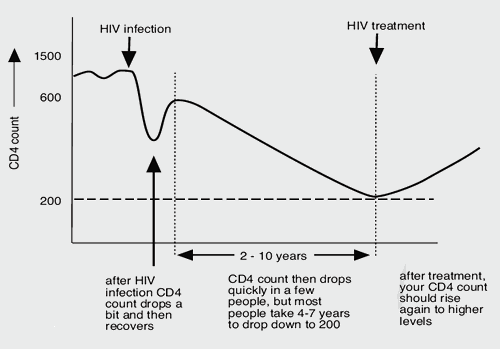
1. 7 CD4 count as a surrogate marker of your immune system
What is a CD4 count?
A CD4 count is the result of a blood test. It tells you how many CD4 cells are in a cubic millimetre of blood (mm3). Information about units of measure for blood tests.
The full medical name is a CD4+ T lymphocyte count. It is also called CD4+ T cell count or a T4 count.
Everyone should have a CD4 test when they are first diagnosed. The result can help estimate how long you might have been HIV positive.
For many years, the CD4 count was used to decide when to start HIV treatment (ART). Since 2015, the result is still important, but ART is recommended for everyone. This is at any CD4 count, even if still high and your immune system is strong.
- Guidelines now say that all HIV positive people should use ART. This is both for individual health benefits and to reduce the risk of transmission.
- This is based on results from the START and TEMPRANO studies in 2015. These results from START study continued out to 2021 during an extended follow-up period.
- A few countries still wait until the CD4 count drops below 500 cells/mm3. This is usually to save money.
Once on effective ART your CD4 count is generally tested less often. As long as your CD4 count is higher than 350 and your are good at taking meds, this might only be once a year in the UK.
- Lower CD4 counts might be tested more often.
- CD4 counts above 500 might only be tested every two years.
- These guidelines might vary in different countries.
CD4 count as a surrogate marker
A surrogate marker is when something that is easy to measure is used as a marker for something more complicated that is difficult to measure directly.
The CD4 count doesn’t directly measure HIV. But it is a good surrogate (or indirect) marker for how HIV has damaged your immune system. It is closely linked to the risk of HIV-related complications.
The normal range for a CD4 count in someone who is HIV negative varies between 400 and 1,600 cells/mm3. This range covers 19 out of every 20 people (95%). But 1 in 20 people who are HIV negative (5%) have a normal CD4 count that is either less than 400 or higher than 1600.
These people are still very healthy. They do not have a stronger or weaker immune system. This is the range for a normal balance.
Pattern of CD4 count after HIV infection
This graph shows the average pattern of CD4 changes after becoming HIV positive.

- A few weeks after infection the CD4 count falls.
- Then the immune system begins to fight back. The CD4 count goes back up again, though not to as high as before HIV infection.
- The lowest level is usually 3 to 6 months after infection (if not on ART). This is called the CD4 set point. The lowest-ever CD4 count is also called the CD4 nadir.
- Without ART, the CD4 count will gradually drop. This usually takes several years. When not on ART, this is by roughly 50 cells/mm3 every year. But some people have CD4 counts that fall much faster or slower than average.
Although most people can keep a good CD4 count without ART for many years, HIV will still be increasing the risk of serious complications.
This is why guidelines recommend ART for everyone.
Last updated: 1 January 2023.
